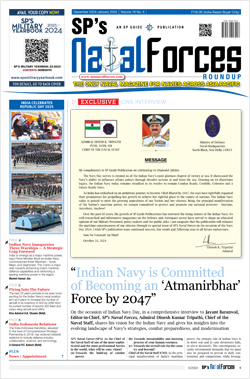INDIAN ARMED FORCES CHIEFS ON OUR RELENTLESS AND FOCUSED PUBLISHING EFFORTS

The insightful articles, inspiring narrations and analytical perspectives presented by the Editorial Team, establish an alluring connect with the reader. My compliments and best wishes to SP Guide Publications.

"Over the past 60 years, the growth of SP Guide Publications has mirrored the rising stature of Indian Navy. Its well-researched and informative magazines on Defence and Aerospace sector have served to shape an educated opinion of our military personnel, policy makers and the public alike. I wish SP's Publication team continued success, fair winds and following seas in all future endeavour!"

Since, its inception in 1964, SP Guide Publications has consistently demonstrated commitment to high-quality journalism in the aerospace and defence sectors, earning a well-deserved reputation as Asia's largest media house in this domain. I wish SP Guide Publications continued success in its pursuit of excellence.
- MoD initiates comprehensive review of Defence Acquisition Procedure 2020, pushes for defence reforms
- G7: The Swansong
- Kalinga Connect: South Asia to Polynesia
- Advanced MRSAM for India for a greater firepower
- Must Credit DRDO for Operation Sindoor, now what is next for defence R&D?
- Operation Sindoor | Day 2 DGMOs Briefing
- Operation Sindoor: Resolute yet Restrained
India's Balancing Act: Managing Strategic Dilemmas
In a rapidly evolving world, India's foreign policy pragmatism allows it to navigate complex global dynamics, seeking support from one or more great powers while retaining strategic autonomy
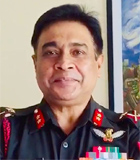 |
The Author is former Chief of Staff of a frontline Corps in the North East and a former helicopter pilot. He earlier headed the China & neighbourhood desk at the Defence Intelligence Agency. He retired in July 2020 and held the appointment of Addl DG Information Systems at Army HQ. |
India's constructive engagements for Global Peace
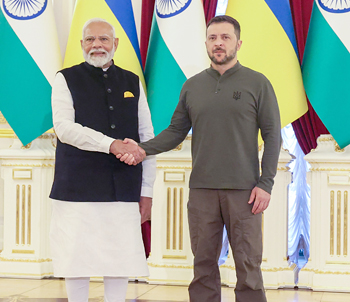
Walking up to an exhibit and memorial for children who lost their lives, locally known as the Martyrologist exposition on children, Prime Minister Narendra Modi put a comforting arm around the shoulder of Ukrainian President Volodymyr Zelensky and assured his personal support and engagement in bringing about a closure to the war raging since February 2022. He urged the Ukrainian Presidents to be ready to sit across the table with President Putin and find an amicable solution. India has been roundly condemned and vilified by the US and other Western leaders as well as western media for its refusal to condemn Russia for the aggression and respect the nearly 16,000 sanctions imposed by the west including pressures not to buy Russia oil.
Only a few weeks earlier, Prime Minister Modi was photographed hugging President Putin on a day when Russian bombed Ukraine's largest children's hospital. This had drawn sharp comments from Zelensky. "It is a huge disappointment and a devastating blow to peace efforts to see the leader of the world's largest democracy hug the world's most bloody criminal in Moscow on such a day," Zelensky, wrote on X.
Prime Minister Narendra Modi urged Ukrainian President Volodymyr Zelensky to be ready to sit across the table with President Putin and find an amicable solution to the ongoing conflict
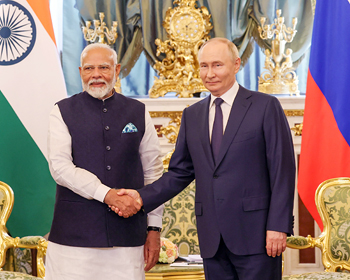
Sooner or later, at least privately, President Zelensky will ruminate over Prime Minister Modi's advice. Two years back, in late April 2022, Russia and Ukraine had almost come to an agreement to end the war, under negotiations conducted by Turkey. Another leader, the Prime Minister of UK, Boris Johnson had to make a swift visit to Kyiv and dissuaded Zelensky from signing the peace deal. Matters today are only far worse, with tens of millions Ukrainian refugees sheltered in neighbouring European countries, Ukraine's infrastructure devastated, its agricultural exports evaporated and its soldiers demoralised and tired. The peace talks in Switzerland, good optics though they maybe, hardly count without Russia's participation. It is uniquely India, as opposed to the war-mongering western leaders, that is urging Zelensky to read the tea leaves carefully and be ready to talk with the Russian leader for an end to conflict.
India's Independent Path of Diplomacy
India's diplomatic tightrope walk regarding the Ukraine conflict is not an exception. A visit to Ukraine and Poland, the latter on the frontline of NATO support to Ukraine' war efforts and host to nearly two million Ukrainian refugees, only signalled to the world that India is not aloof to the misery caused by wars, whether in Ukraine or in the Gaza. At the same time, it does not believe in cancel culture of completely demonising one party or the other. Instead, India believes that restoring peace is the best option for both belligerents in these two theatres and any lasting peaceful solution can come through engagement and not isolation.
India has been criticised by the US and other Western leaders for its refusal to condemn Russia for the aggression and respect the sanctions imposed by the West, but continues to advocate for peace through dialogue
Only two years back, as the last waves of the Covid pandemic receded in July 2022, Israel announced that it would sell the port in Haifa, a major trade hub on the Mediterranean, to winning bidders Adani Ports of India and local chemicals and logistics group Gadot. The deal was eventually completed in January 2023. At that time, no one had imagined that barely ten months later, Hamas will launch a daring raid into Israeli kibbutz at the crack of dawn on October 7, 2023, indulge in wanton rape, murder and take hundreds of hostages setting the Middle-East on fire. The war has sucked in many players in the region including the US and Iran and is reverberating across the globe in the form of often-violent pro-Palestine rallies across major capitals in the western hemisphere.
It soon became abundantly clear that Hamas drew its strength from Iran and its 'Axis of Resistance'. The Hezbollah in Lebanon and the Houthis in Yemen joined forces. Israel killed a number of Iran Revolutionary Guards Commanders by bombing its Consulate in Damascus and Iran ceased to be playing proxy, more so after the killing of visiting Hamas Chief Ismail Haniyeh in Teheran on July 31, 2024. The world waits with baited breath if and when a direct and devastating war breaks out between Iran and Israel.
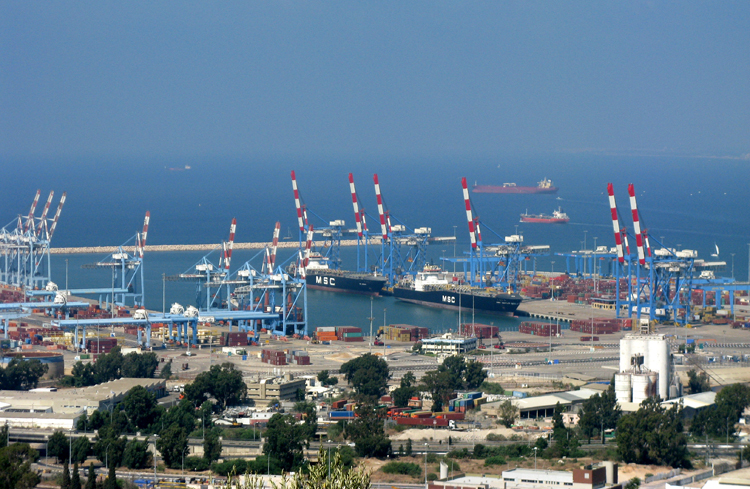
In this tense situation, India has characteristically placed its baits on both sides of the divide. Israel directly attributes the Hamas raids to moral as well as material support from Iran. Yet India went ahead and signed a 10-year contract with Tehran on May 13, 2024 to develop and operate the Chabahar port on Iran's South-Eastern coast along the Gulf of Oman as a way to transport goods to Iran, Afghanistan and central Asian countries, bypassing the port of Karachi and Gwadar in its rival Pakistan. As expected, the US State Department warned that "Any entity, anyone considering business deals with Iran - they need to be aware of the potential risks that they are opening themselves up to and the potential risk of sanctions." Was India backstabbing its friend Israel with whom it enjoys exceptionally close strategic and trade relationship by making deals with Iran?
India is not navigating contrasting situations or diplomatic crossroads for the first time though. India became independent with a battered, fragile economy and devastated by partition, yet it still held high aspirations in the midst of the Cold War between the US and the Soviet Union. We chose the path of 'Non Alignment', with the intention to create more choices and traction in our foreign policy. The idea of non-alignment has remained a central component of India's identity in global politics, evident in its continuities.
India's diplomatic tightrope walk regarding the Ukraine conflict exemplifies its belief that restoring peace is the best option for both belligerents, achievable through engagement rather than isolation
This deft balancing is best exemplified in its dealing with China. Despite unsettled and active borders and about 41,000 square kms of Indian territory under its occupation in Aksai Chin area and the Shaksgam Valley illegally ceded by Pakistan in 1963, China still is India's largest trading partner clicking $118 billion in two-way commerce in 2023. Both are key players in the BRICS formulation and the SCO. At the same time, India is a key component of the US led QUAD which is considered as an anti-China grouping. Both are strange bed-fellows in third countries such as Israel where China's Shanghai International Port Group (SIPG) last year opened a new port across the bay in Haifa. The presence of rivals China's SIPG and India's Adani-led group in Haifa is typical of the diplomatic crossroads that powerful nations must skilfully navigate to retain their strategic autonomy and influence across the board.
India's Strategic Autonomy
The most trying circumstance, of course, arose in February 2022 when Russia launched security operations into Ukraine. Russia was ejected from the global financial arrangement SWIFT, the US led west imposed a plethora of sanctions on oil and gas originating from Russia and impounded $300 billion of its reserves stashed in western banks. There was immense pressure on India to follow suit, condemn Russian aggression and stop importing its oil.
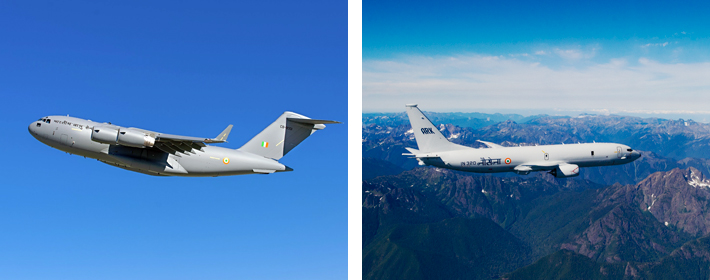
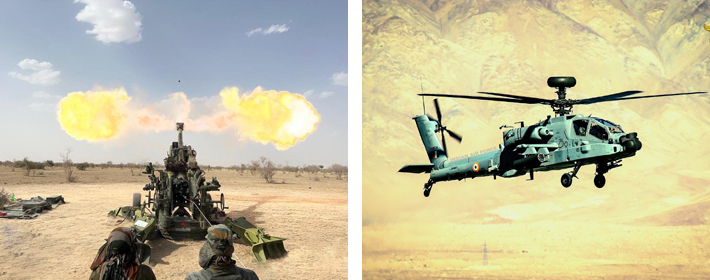
(Clockwise from Top Left) C-17, P-8I, Apache and M777
India chose to do exactly the opposite, and continue its deep engagements with Russia as a reliable and trusted defence partner. Russian oil now accounts for nearly 20 per cent of India's annual crude imports, up from just two per cent in 2021. The US is miffed, yet it has continued to engage with India in pursuit of its strategic goals of seeking to balance China's growing power and influence. US has hugely enhanced its defence supplies to India to include transport and maritime aircraft (C-130J Super Hercules, C-17 Globemaster IIIs, and P-8I Poseidons); transport, maritime, and attack helicopters (CH-47F Chinooks, MH-60R Seahawks, and AH-64E Apaches); Harpoon anti-ship missiles; and M777 howitzers, among others. India is now the largest operator of C-17s and P-8Is outside of the United States. In mid-August, the US State Department has approved a possible Foreign Military Sale (FMS) of Anti-Submarine Warfare Sonobuoys and related equipment for Indian Navy's US supplied MH-60R helicopters at an estimated cost of $52.8 million.
India has chosen to aggressively pursue its vital national interests by charting its own independent course amid complex geo-strategic situations, particularly in its relations with Russia and China
Essentially, India has chosen to aggressively pursue its vital national interests by charting its own independent course and seeks to draw the best deal out of complex geo-strategic situations.
Near home, India confronts neighbours who find it profitable to play one big neighbour against the other. China has been successful in roping in all our neighbours into its Belt and Road Initiative riding on its economic heft. Yet India has continued to keep its doors open for these very neighbours who court China for temporary political benefits but get drowned in debt like Pakistan, Sri Lanka, Maldives and now Bangladesh which has witnessed a violent regime change. Imbibing the Mandala principles of Chanakya and applying them to current and emerging world scenarios can open up many strategies to protect our nation and achieve the right balance in the regional and global stage.
In times of war and crises, when India needs capability and political support, she has to cross its foreign policy thresholds and find pragmatic routes to seeking support from one or more of the great powers. The sole hegemon, the US, is confronted with a humongous sovereign debt of $35 trillion and its petro-dollar reserve status is under real threat, China may be staring at an economic slow-down as exports dwindle, adverse climate events cause devastation and a demographic catastrophe resulting from its five-decades old one-child policy threatens the core of its society, and the EU fumbles as it gasps for breath burdened by stagflation or worse - recession, a cost of living crisis, de-industrialisation and illegal migration, In such a rapidly evolving world, defining great powers itself is a big question mark.





